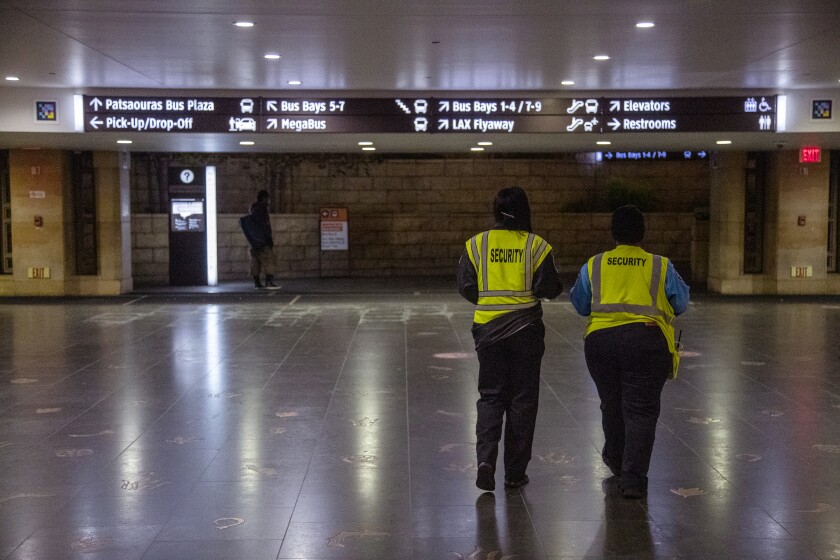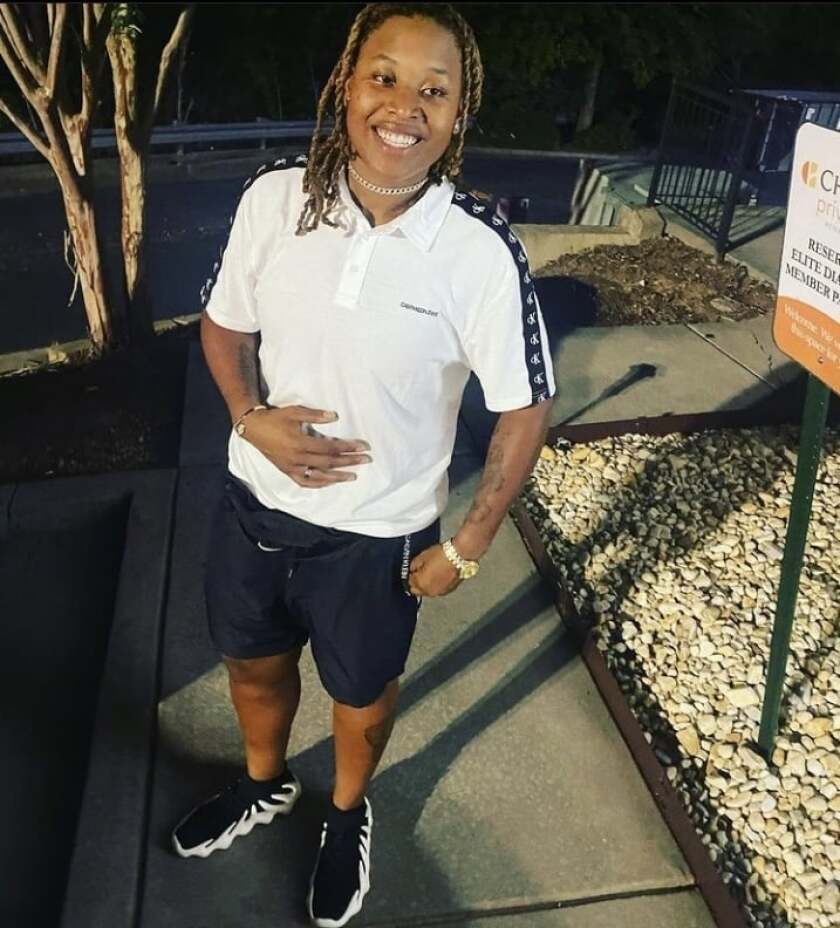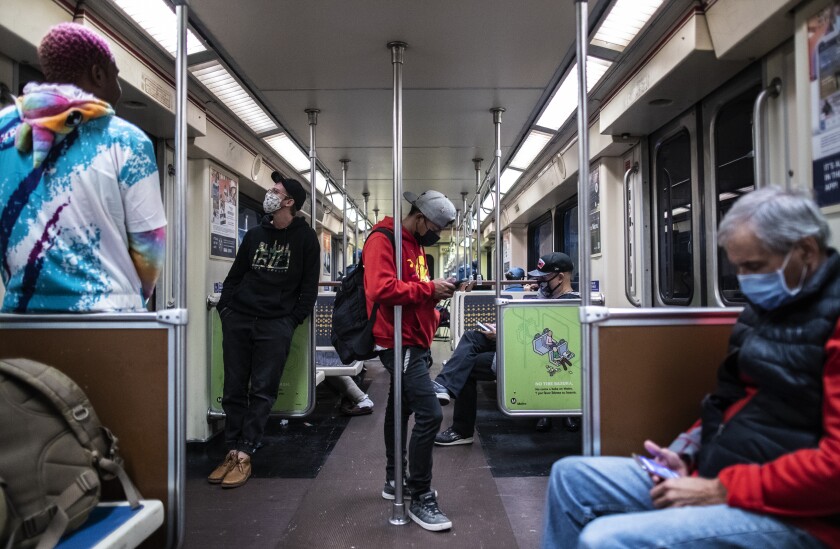As she waited for a Metro train in Hollywood, Maritza Mancilla shielded herself behind the escalator bringing passengers down into the fluorescent lit underground.
She wanted to see the newcomers before they could see her.
The 55-year-old, who relies on public transportation to get to her job as a house cleaner, has seen fights break out on the train. She’s seen a man attempt to open the car doors while they were in motion. At the Hollywood/Western Metro station earlier this year, a man exposed himself to her.
“If I could work from home, I would,” she said.
With the pandemic easing and lockdowns lifted, a return to normalcy has come with benefits: increased economic activity, more people going back to work and school and holiday gatherings and social interactions.
But on the Los Angeles public transit system — where ridership has rebounded to about 843,000 weekday daily riders from a pandemic low of about 363,800 — normal has also brought with it a rise in crime.
In 2021, through September, reports of violent crimes were up 25% from the same time last year and 9% from 2019, according to L.A. County Metropolitan Transportation Authority data. Some crimes, such as aggravated assaults, are exceeding pre-pandemic levels even though bus and rail ridership hasn’t fully recovered.
Although still rare, homicides jumped from one in 2019, to three in 2020, the first full year of the pandemic. So far in 2021, five people have been killed in stations or on public transport, including a 28-year-old woman fatally shot on the train while on her way to work.
While most people ride public transit without incident, the issue of crime recently sparked a clash between L.A. County Sheriff Alex Villanueva and Metro board members over the future of law enforcement on the system. At a news conference to argue for the extension of his department’s contract with Metro, the sheriff rattled off a list of eight violent crimes, dating back to 2019, including shootings, stabbings and sexual assaults. He referred to the incidents as “the level of carnage” happening on trains.
Inglewood Mayor James T. Butts, who sits on the Metro board of directors, said that he saw Villanueva’s compilation of violent crimes, “as a public acknowledgement that he failed to prevent these crimes.”
Butts, a former Santa Monica police chief, added that given the enormous scale of the public transit system, there was no reason to try to frighten people with crime numbers.
“The press conference was a political exercise that gave statistics without perspective,” Butts said during a Metro committee meeting. “Given the millions of riders that Metro serves every year, the crime statistics compared per capita to cities are de minimis.”

Commuters ride an escalator up to street level at the North Hollywood station on the Metro Red Line on Tuesday, Nov. 16, 2021 in Los Angeles, CA.
(Brian van der Brug/Los Angeles Times)
On a recent Friday morning, more than a dozen people heading to work, school or to run errands waited for their train at the Hollywood/Western station.
Maria Herrera had just gotten off an eight-hour night shift. The 55-year-old, who can’t drive, relies on her daughters and public transportation to get to work five days a week.
Herrera said she stopped taking the train at night a long time ago and relies on ride share apps, which have come at a rising cost.
“Poor people are suffering the most,” said Herrera. But when it comes to crime, she said, “we’re all exposed.”
“It doesn’t matter if you’re older or younger,” she said. “That’s why a lot of people don’t stop using their cars.”

Security personnel walk through Union Station on Nov. 16.
(Brian van der Brug / Los Angeles Times)
This year, through September, there were 470 violent crimes systemwide. In 2020, over the same time period, there were 375. In 2019, before the pandemic began, there were 432.
Robberies have dropped from the last two years, to 165, but reports of homicides, rapes, aggravated assaults and aggravated assaults on operators were higher this year during the same time in 2019 and 2020.
Judy Gerhardt, Metro’s chief of system security and law enforcement, said the uptick in crime appears to be part of a larger trend across the U.S.
“As our community deals with the challenges that are brought on by COVID, the increase in the unsheltered population on the system, other social factors that are happening now, we’re seeing crime rates rise — not just on the system but locally and even across the country,” Gerhardt said. “Our goal is to minimize all crimes on the system in every capacity.”
There have been five homicides this year, with the most recent coming on Nov. 21, when a man was shot in the head at the Willowbrook/Rosa Parks Metro Station. Suspects in all the killings are in custody.

Danielle Harlemon, 28, was fatally shot while taking the train to work on Oct. 10.
(Eddie Harlemon III)
For the family of Danielle Harlemon, her death was as unexpected as it was far from the place she once called home.
The 28-year-old followed her dream to move to California from Atlanta two years ago. Her older sister said she loved the ocean.
Nearly every day, Harlemon woke up before the sun rose to make it on time to the downtown L.A. marijuana dispensary where she worked as a master grower.
Her mother, Demetria, said on a few occasions she overheard her daughter being harassed at the train station during their daily calls.
“I asked her, ‘Where is security? How does all of this go on on public transportation?’” Demetria, 54, recalled. “Why isn’t there someone to give you some kind of comfort?”
Harlemon wanted to start driving and was saving to buy a Jeep by Christmas.
On Oct. 10, Harlemon was seated on the Metro B line train, when an agitated man began pacing nearby. He started arguing with her. When the train stopped at the Hollywood/Vine station, the man shot Harlemon and fled, police said. She died at a nearby hospital.
“It breaks me down every day that she was on her way to work,” Demetria said. “For this to happen has just put me in a state of shock.”
Less than a month later, police arrested 23-year-old Andre Dunlap, who had fled to his home state of Indiana. Dunlap, who was unhoused at the time of the shooting, was on parole for attempted robbery in Los Angeles, according to the LAPD. He’s since been charged with murder.
Villanueva cited Harlemon’s death at the news conference on Nov. 17. He criticized Metro’s Public Safety Advisory Committee for recommending a shift to non-law enforcement alternatives, such as transit ambassadors, which he said would provide “an illusion of security.”
“We need to take these matters seriously because lives are at stake, lives are being endangered on the system and the callous disregard for the safety of the passengers is alarming,” Villanueva said.
Since 2017, Metro has split policing duties among the Los Angeles Police Department, which patrols buses, trains and stations in the city of L.A.; the Long Beach police, who work at eight Blue Line stations; and the L.A. County Sheriff’s Department, which patrols the rest of the system. The contracts expire in 2022.
Following protests in the wake of George Floyd’s murder, the Metro board of directors sought recommendations on how to reform the agency’s policing practices and reallocate resources to other forms of community safety, resulting in the establishment of a Public Safety Advisory Committee.
The committee has recommended that the board not allocate any additional funding to existing public agency policing contracts and to reallocate that money to support mental health, homeless outreach services and unarmed transit ambassadors who can de-escalate potentially violent situations.
Villanueva “pointed to crimes and people feeling unsafe on transit. The contracts have ballooned throughout the years, and we don’t see the transit system feeling safer,” committee member Scarlett De Leon said. “For PSAC members, and for myself, it’s like, what else can we do that actually addresses safety at the root of it?”
Metro has recommended that the board approve funding the remaining six months of law enforcement contracts, at a total of $75.2 million, and authorize an extension of up to one year. In a statement, the agency said that would give the Public Safety Advisory Committee “sufficient time to finalize its long-term recommendations.”
Metro board members criticized Villanueva during an Operations, Safety, and Customer Experience Committee meeting last Thursday.
“The head of an agency that is charged with providing public safety on this system held a press conference and tried to scare and frighten the riders of our system … tried to create panic,” said L.A. Councilman Mike Bonin, chair of the committee. “We have an agency led by a guy who hasn’t provided public safety, who hasn’t managed the contract well and then wants more money.”
On Dec. 2, the board will vote on whether to fund the remaining six months and extend the contracts.

Subway riders take the Metro Red Line on Nov. 16.
(Brian van der Brug / Los Angeles Times)
At the Hollywood/Western station, Richard Diamond waited to board a train heading to North Hollywood. Diamond, who lives in Glendale, takes public transportation every month to get to doctor appointments in Encino.
When it comes to police presence, he’s quick to say that it should be “cut back.”
“They’re only there to give you a ticket and harass you. They’re not there for safety reasons, per se,” said Diamond, who is Black. “When do you really see them handling a problem other than giving a ticket or worrying if you’ve paid for your fare? It’s more of a harassment thing than actually doing anything I’ve seen helping.”
The 47-year-old said he doesn’t worry about taking the train. When he was unhoused for a decade, he would take it up to North Hollywood, come back down and then make his way to Long Beach. But he would always “sleep with one eye open.”
“You’re never really safe, especially in the big city,” Diamond said. “But, in general, people are looking out for each other, whether you realize it or not.”





